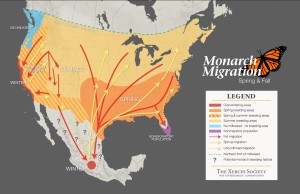As long-time readers of this blog may recall, Monarch butterflies and their migration have always fascinated me. I even worked them into my YA fantasy series Misaligned, which I featured in an earlier blog post. Despite all of their wonderful attributes Monarchs cannot survive cold winters. Their solution is to undertake a cross continental migration. Those west of the Rocky Mountains take a relatively short trip to winter in several locations along California’s coast. Some of the eastern Monarchs winter in Florida, but the vast majority them winter in a very small area of Mexico. For some of them that’s a trip of nearly 3,000 miles. Butterflies from southern Canada, New England, and the upper Midwest begin their epic journey before the end of summer. Several generations later their offspring fly through the ‘Texas Funnel’ and arrive at their wintering grounds in the Mariposa Monarca Biosphere Reserve in Mexico.
Threatened Monarchs
If you’re not an avid newspaper reader, a frequent listener to NPR, or an entomologist you might not be aware of the concern for the Monarchs. Over the last twenty years their wintering populations have dropped by 90%. Two factors are contributing to the precipitous decline. Natural weather fluctuations over the last several years have been more severe than normal. The drought in the Southwest reduced the number of nectar producing plants in Texas. Every migrating butterfly in the east passes through Texas and counts on that nectar to survive the five month wintering season (That’s another oddity, an adult Monarch lives ~3 weeks, those of the wintering generation live seven times longer). Less nectar means fewer butterflies survive the winter to start the next northward migration.
The other leading factor is habitat loss caused by deforestation in Mexico and the use of powerful herbicides (primarily glyphosate commercially known as roundup) in the American Midwest. Newer food crops are more resistant to the glyphosate, which allows farmers to use more of it. The upside is more food, which in a world where many go to bed hungry is an admirable thing. Unfortunately, the downside is that with higher use the herbicide’s impact stretches beyond the crop fields. Wild plants that used to thrive along roadsides and the edges of fields are being decimated. These native plants include nectar producers and milkweed. The former feeds the adults, while the latter is the only food source for the caterpillars. The combination of these two factors has created the Monarch butterfly crisis.
Barring a ‘Star Trek-like’ weather controlling technology there’s not much we can do about the weather. The EPA is looking at the glyphosate issue, but it’s not entirely clear what if anything they can or should do. If you’re interested in learning more about the marvelous Monarch butterfly and the problems they’re facing please follow the links below.
As always thanks for reading.
Armen
Newsletter
As an aside please consider signing up for my FREE author newsletter. It will contain opportunities to preview new books, announcements, and contests related to my novels. It will not overwhelm your inbox – I’m thinking once a month or less depending on news.
If you have subscribed, but haven’t received a newsletter, please check your spam folder. Moving the newsletter to your inbox should fix the issue.
Now back to our regularly scheduled programming.
Butterflies in your playground (Special thanks to Elliot for this link)
Creating a Pollinator Garden (Special thanks to Corrine & Michelle Bass)
Two additional links courtesy of Mrs. A. Jones & Melissa
A Guide to Butterfly Gardens
https://www.avasflowers.net/a-
Creating Pollinator Gardens: Flower Fragrances to Attract Pollinators
https://www.fragrancex.com/fra



Fascinating. With regard to changing habitat, it seems to me that they’ll figure it out best without us humans. Every time humans try to fix an element of nature, we seem to make things worse. (…just my opinion).